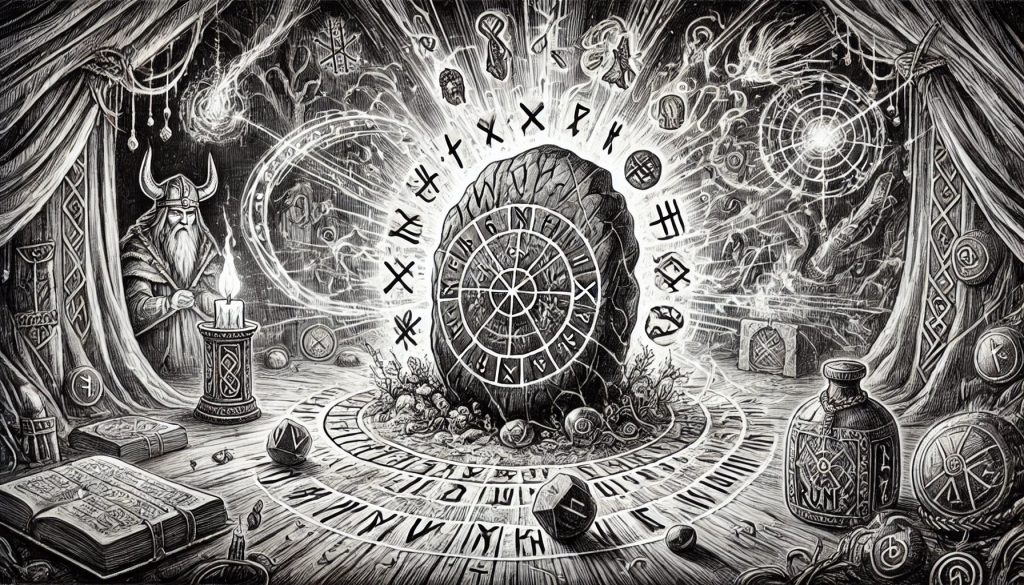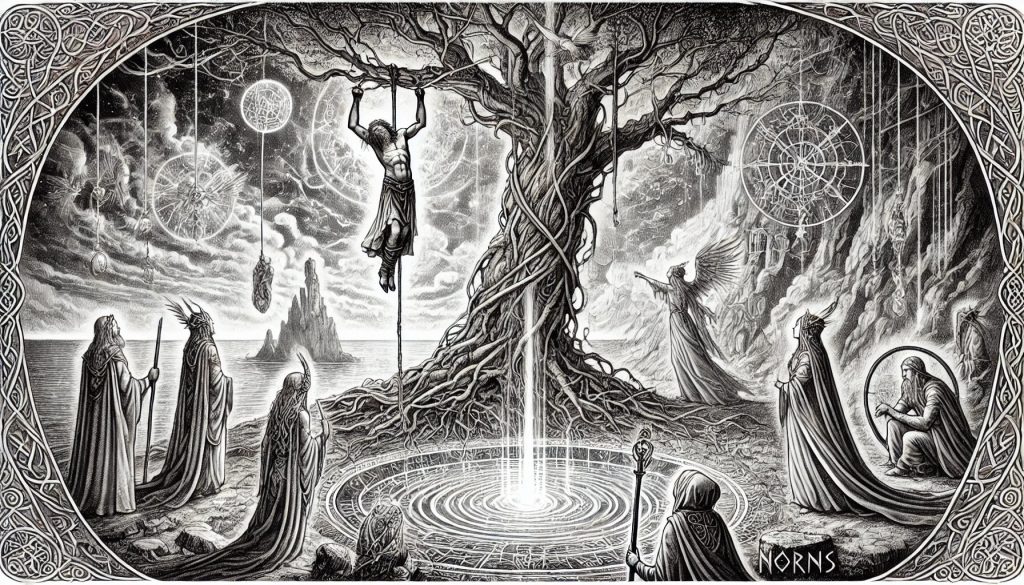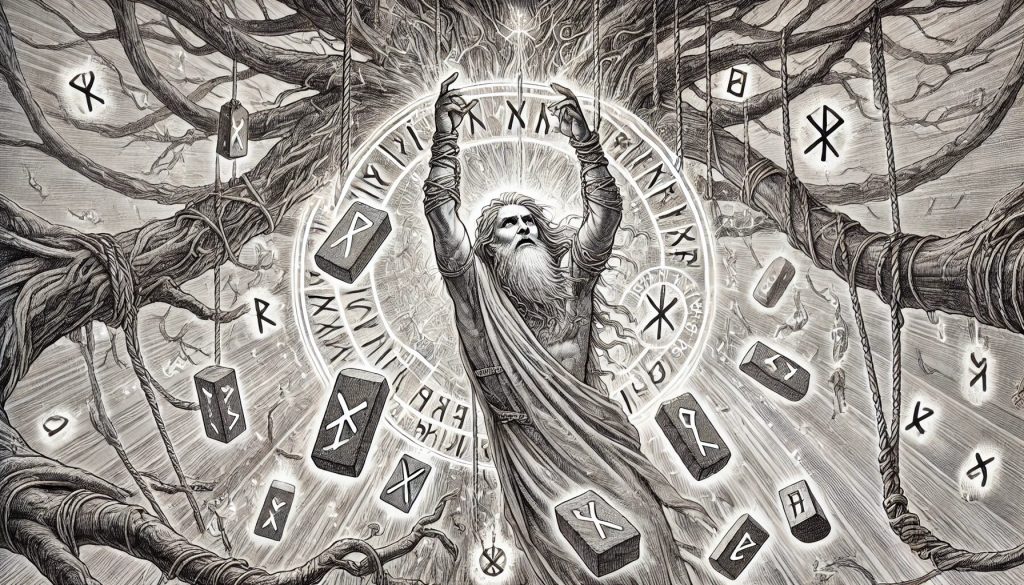Aesir Gods, Norse Gods, Norse Mythology, Norse Runes, Odin, Tales of the Gods, The Norns, Yggdrasil (World Tree)
Odin Discovers The Runes
In Norse mythology, a story tells of Odin’s quest to find the runes’ secrets. These symbols were key to knowledge, power, and the universe’s structure. His journey, filled with sacrifice and discovery, changed Germanic beliefs and traditions.
Odin, the Allfather, wanted wisdom and understanding deeply. He searched for the runes’ power, reaching Yggdrasil’s roots. There, he hung himself for nine days and nights, risking death to gain the runes’ secrets.
Introduction to the Tale
In Norse mythology, the story of Odin finding the runes is key. It shows the deep wisdom and sacrifices of the Allfather. This tale is found in the Poetic Edda and Hávamál. It tells of Odin’s search for knowledge, meeting with the Norns, and creating the runic alphabet.
The story takes place under the World Tree, Yggdrasil, a huge ash that links the nine realms of the Norse world. The Norns, three sisters who control fate, watch over the well of Urd, full of cosmic knowledge; Odin watched the Norns to understand deeper truths. Odin starts his journey here, seeking the universe’s secrets.
Odin’s discovery of the runes is more than just a story of magic. It’s a deep look at wisdom, the price of knowledge, and the lasting impact of the runic alphabet on the Germanic people. This tale shows the rich and complex world of the old Norse, where seeking knowledge is part of the cosmos.
Who is Odin?
Odin is a key figure in Norse mythology, known as the Allfather of the gods. He rules Asgard, one of the nine worlds where many gods and goddesses reside. Odin is respected and admired by gods and humans.
He is a god of wisdom, knowledge, and magic. Odin seeks knowledge deeply, even sacrificing an eye for it. This shows his deep commitment to learning and wisdom.
The Allfather of the Norse Gods
In Germanic traditions, Odin is also called Woden or Wotan. He is the top god of the Aesir, controlling Asgard and having great power and authority.
In Norse mythology, Odin rules the Nine worlds. He is known for his wisdom, knowledge, and magic. He is also clever and strategic.
- He carries a powerful spear called Gungnir that always hits its mark. Odin also wears a hat that hides one of his eyes. He gave up an eye for wisdom from Mímir’s well, willing to sacrifice almost anything for knowledge.
- Odin’s search for knowledge is a big part of Norse mythology. His readiness to sacrifice shows his strong will.
As the Allfather of the Aesir, Odin’s impact on Old Norse mythology is huge, reflected in the stories of Odin and the runes. His finding of the runes, an ancient Germanic alphabet, is a key event in Poetic Edda and Norse mythology.
The Importance of Runes in Norse Mythology
In Norse mythology, the runes were very important. They were more than just an old alphabet. These symbols were filled with magical power. They were used for divination, spellcasting, and other mysterious arts.
Runes as Symbols of Power and Divination
The runes were not just letters. They were seen as magical symbols that held deep knowledge of the universe, symbols then carry the wisdom of the cosmos. The Elder Futhark and the Younger Futhark were sacred alphabets. Each rune had its own special meaning and magical powers.

The Elder Futhark was used by ancient Germanic tribes, including the Norse. They used it for many things, like carving on stones or divination. The Younger Futhark came later and was used a lot in old Norse culture. It’s found in the poetic edda and other writings.
- Runes were thought to have the power to change events and connect with the unseen forces of Norse mythology.
- They were used for spells, healing, and even curses, showing their double nature.
- People used runes for divination to get guidance and understand the universe better.
The runes were more than a way to write. They were a way to connect with the divine and the unknown, enabling gods and goddesses to communicate with humans. They played a big role in Norse mythology. The Germanic peoples deeply respected these alphabet and divination tools. They saw them as a link between the world of humans and the world of gods.
Odin’s Quest for Wisdom
Odin’s journey is all about seeking knowledge and wisdom. As the Allfather of the Norse gods, he wanted to learn the secrets of the runic alphabet. This language was thought to unlock cosmic understanding.
Odin’s Sacrifice for Knowledge
Odin was determined to acquire this wisdom and made a big sacrifice. He hung himself from the World Tree, Yggdrasil, for nine days and nights without food or water.
This act showed his deep commitment to his quest for wisdom.
While hanging, Odin learned a lot about the runes and the cosmic forces that shape the nine worlds of Norse mythology. His sacrifice let him unlock the runes’ secrets, which became powerful tools for divination and understanding the Germanic and Old Norse worlds.
Odin also gave up one of his eyes for a drink from the Well of Urd, cared for by the Norns. This shows his deep commitment to gaining knowledge and wisdom, even his willingness to sacrifice almost anything. His story, found in the Poetic Edda and the Hávamál, made him known as a seeker of truth and a Runic master.
The Sacrifice: Hanging from Yggdrasil
In the old stories, Odin, the Allfather, went on a quest for the most knowledge and wisdom. He ended up at the huge Yggdrasil, the World Tree, where he made a deep sacrifice, standing beneath its upper branches.
Odin, eager for knowledge and wisdom, hung himself from Yggdrasil’s branches for nine days and nights. He looked into the Well of Urd, watched by the Norns, who control fate.

Odin’s Vision and the Norns
While hanging, Odin had a deep vision that showed him the true power of the runes. The Norns, who watch over destiny, shared the secrets of the well of Urd with him. Ancient Germanic and Old Norse knowledge, influenced by the gods and goddesses, comes from this.
Odin learned a lot from this tough experience. He understood the world tree and the nine days and nights he spent hanging. This story, found in the Poetic Edda and the Hávamál, made Odin known as the one-eyed seeker of knowledge and wisdom.
The Discovery of the Runes
After Odin’s sacrifice and vision of the great tree Yggdrasil, he gained the deep knowledge he wanted. The secrets of the runes, the mystical letters called “runes”, were shown to him. These letters formed the elder futhark and younger futhark alphabets used by Germanic peoples.
Odin’s discovery of the runes was a turning point in old Norse mythology. It changed the culture of the region. The word “rune” comes from the Germanic root meaning “secret” or “mystery.” This shows how important Odin’s discovery was.
Odin’s Revelation and the Birth of the Runic Alphabet
In a moment of divine insight, Odin understood the true power of the runic alphabet. He saw that these symbols held not just language but also secrets, magic, and the universe’s secrets. With this knowledge, Odin carved the first runes.
These runes became the foundation of a new era, and their magical symbols carried immense power and knowledge. They shaped the culture and spiritual identity of Germanic peoples for centuries. From this moment, the elder futhark and younger futhark alphabets were born. They changed old Norse history and legend forever.
The Meaning and Power of the Runes
The runes were more than just an old writing system. They were magical symbols full of deep power and meaning. People believed they could unlock the universe’s secrets, which allowed those who knew the runes to predict the future, talk to the gods, and control the forces of nature.
Runic Magic and Divination
Divination was at the core of runic magic. Practitioners would cast or carve runes to see into the past, present, and future. These runes were seen as carrying the wisdom of the Poetic Edda and Odin’s teachings from the Hávamál and Sigrdrifa. By reading the patterns of the runes, experts could predict the future and understand the world’s forces.
Carving runes was also a magical act. It was a way to connect with the runic magic. The runes were seen as a link to the divine, whether for divination, spells, or sacred messages. They helped those who wanted to uncover the universe’s secrets.
- Runes as symbols of power and divination
- Harnessing the wisdom of the Poetic Edda and Odin’s teachings
- Carving runes as a magical act to channel elemental forces
- Interpreting the patterns of fallen runes to foretell the future
- Runes as a conduit to the divine and a means to unlock cosmic mysteries were central to the stories of Odin and the runes.
The Legacy of Odin’s Discovery
Odin, the Father of the Norse gods, found the runes. This event left a lasting impact that still fascinates us today. The runes, with their mysterious symbols, have stayed important in the culture of the Germanic peoples, even after Odin and the Norse gods were mostly forgotten.
The Enduring Influence of the Runes
As the Latin alphabet became more common, the runes didn’t disappear. They kept their magical meanings and continued to shape the beliefs of the Germanic peoples. The Poetic Edda and Hávamál, filled with Old Norse poems, show how much the Elder and Younger Futhark alphabets were valued. They were seen as keys to runic magic and divination.
The runes have deeply influenced the culture of the Germanic peoples. Their symbols and letters appear in art, literature, and even modern occult practices. They prove the lasting impact of Odin’s discovery of the runes.
Themes and Lessons from the Tale
The story of Odin finding the runes has deep meanings in Norse mythology. It shows the respect for wisdom, knowledge, and the universe’s forces in Germanic and old Norse cultures. At its core, the tale tells of Odin’s deep desire for understanding, even if it means great personal cost.
Odin’s Sacrifice and the Pursuit of Wisdom
Odin gave up one of his eyes to get the runes’ knowledge, demonstrating his willingness to sacrifice almost anything. This act shows the strong impact of wisdom. By doing this, Odin shows how much he values deep insights into the world and the mysteries of the universe.
This story from the Poetic Edda and Hávamál teaches us a lesson. It says that getting knowledge and wisdom often means facing our limits and making tough choices, as demonstrated in the tales of Odin and the runes. Odin’s story tells us that the journey to enlightenment is hard, but the benefits are huge.
Norse mythology urges us to be curious, resilient, and open to the unknown through this tale. Odin’s discovery of the runes and runic magic shows the power of knowledge. It also highlights the importance of facing challenges to uncover the world’s secrets.
Conclusion
The story of Odin finding the runes shows us the deep impact of this myth from Norse mythology. The Germanic people have always seen this story as key to gaining knowledge and wisdom. It shows how sacrifice can change us and leave a lasting legacy.
The story takes us from the mighty Yggdrasil, the World Tree at the center of the world, to the mysterious Norns who control fate. Odin’s journey to find the runes is a key part of Norse mythology. The Poetic Edda and Hávamál keep alive the wisdom Odin learned, making this myth very important to us.
Today, we still face big challenges in seeking knowledge and personal growth. The story of Odin finding the runes reminds us of the power of sacrifice and our quest for understanding. This tale from Norse tradition still moves and inspires us. It shows how myths can be powerful and still relate to us today.

